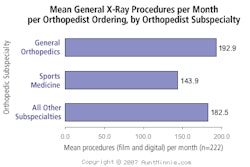Diagnostic imaging in California was put under the spotlight when a report came out earlier this week suggesting that up to one-third of advanced imaging exams were being billed by physicians who exploit exceptions in the Stark II law to self-refer patients for these services.
"Nearly 33% of providers who submitted bills for MRI scans, 22% of those who submitted bills for CT scans, and 17% of those who submitted bills for PET scans were classified as self-referral," wrote Jean Mitchell, Ph.D., in a study published online before print in the journal Health Affairs (April 17, 2007).
Mitchell, a professor of public policy at Georgetown University in Washington, DC, and colleagues analyzed the 2004 providers' billing records for ambulatory services of a large private health insurer (more than 5.8 million lives) in California. Her team obtained a list of providers who submitted claims for either the technical component or the global fee (both professional and technical components) by procedure type for MRI, CT, and PET scans.
"By applying this selection criterion, we attempted to screen out radiologists who only billed for the professional fee for the interpretation of the scan," she wrote. "Since these physicians typically work out of hospitals, the technical component billed by the hospital would capture each imaging procedure performed."
Mitchell's group then contacted each provider by telephone and inquired if the MRI, CT, or PET scan was offered onsite. If not, they found out the facility where the patient had been referred. If the provider offered the advanced imaging services onsite, Mitchell's team determined the type of facility where the procedure was provided and details on the equipment used to perform the exam.
"Between Internet searches, multiple telephone calls, and analysis of claims to ascertain a count of each procedure type performed and amount billed during each given year, we spent an average of two hours per case to obtain complete information on each provider," she noted.
For purposes of the study, imaging equipment owned or leased by nonradiologist physicians in groups of 100 or fewer, as well as large multispecialty physician practices of 100 or more members, were deemed to be self-referrers. Radiation oncologists and independent diagnostic testing facilities (IDTFs) were classified as indeterminate referrers. Radiology practices that own or lease equipment, either on their own or in a joint-venture arrangement with a hospital were nonreferrers. Hospitals, unless a specialty facility owned by referring physicians, were also classified as nonreferrers.
Working the system
Mitchell's group examined 1,023 MRI providers, 964 CT providers, and 174 PET providers that billed for the technical or global provision of these services in 2004.
"Approximately 33% of providers who submitted either global or technical bills for MRIs were nonradiologist physicians practicing in small to medium-size groups and involved in self-referral," she wrote.
Her team also determined that almost 22% of the CT exams and slightly more than 17% of the PET scans in California in 2004 were billed by members of small to medium-size physician groups who engaged in self-referral.
When they dug deeper into the self-referrers' patterns, they found that almost 61% of the nonradiologists who submitted global bills for MRI did not own the equipment, nor was it located onsite. In contrast, nearly 70% of the PET self-referrers had the modality at their location.
"Nearly 64% of the self-referral CT providers who worked in small to medium-size groups billed the insurer but had either a lease or payment-per-click arrangement," Mitchell wrote. "Thus, only 39% of the MRI providers and 36% of the CT providers who engaged in self-referral had the machines located at their practices."
Not only are these practices self-referring imaging studies, but Mitchell's data indicate that they may be abusing the utilization of advanced imaging technologies.
For MRI procedures in 2004, the self-referral group accounted for 11.5% of the statewide volume for the modality's utilization. CT procedures performed by self-referrers that year was less than 7% of the statewide volume, but PET exams conducted by self-referrers exceeded 25% of the statewide volume.
"These prevalence rates are probably conservative with respect to the situation in 2007 because they identify arrangements in existence during 2004 and do not reflect developments since then," Mitchell noted.
Of particular concern to Mitchell's research team is that the majority of self-referral for MRI and CT scans are conducted by physicians who do not have imaging equipment in their office; essentially, these groups have taken advantage of exemptions in existing law at minimal financial risk.
"Such referral arrangements raise concerns about referring physicians' ability to monitor the quality of care provided because the referring physicians are not onsite to directly supervise the provision of imaging services and the site's operation," Mitchell wrote. "Finally, arguments regarding patient convenience appear to be tenuous at best, especially if the referral arrangement is structured as a 'sham lease' agreement."
Mitchell's team indicated that these self-referral patterns are not confined solely to CT, MR, and PET; the group has conducted preliminary research on cardiac nuclear imaging procedures and has found that the data point to similar self-referral arrangements being commonplace in this area.
"These findings should be of considerable concern to policymakers, employers, insurers, and consumers who recognize the need to control rapidly escalating healthcare spending," Mitchell concluded. "Efforts that address the exemptions in existing federal and state prohibitions on physician self-referral are likely to have major impacts on the increased use that characterizes these arrangements."
By Jonathan S. Batchelor
AuntMinnie.com staff writer
April 20, 2007
Related Reading
DRA's arrival forces imaging centers to adapt, February 1, 2007
Illinois AG's lawsuit may chill equipment leasing deals, January 24, 2007
DRA threatens to throttle PET, October 13, 2006
Study finds 87% of DRA reimbursement below procedure cost, September 19, 2006
Reassignment rule proposal offers mixed bag for imaging, August 18, 2006
Copyright © 2007 AuntMinnie.com



















